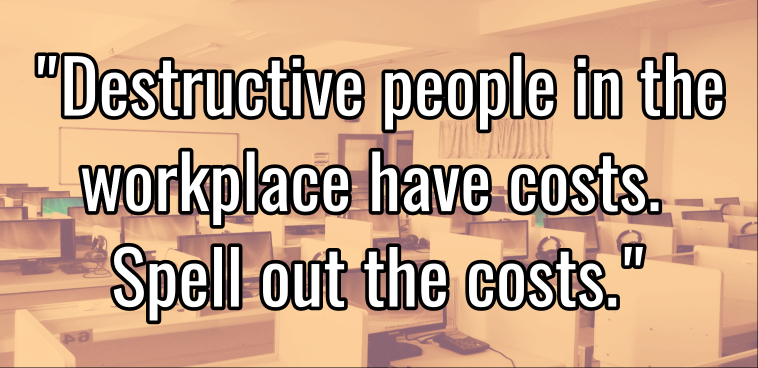Accounts of egregious workplace behavior are suddenly all over the news – again. Harvey Weinstein and Mark Halperin are just two of the more notable figures recently identified of being guilty of such behavior.
Does such behavior exist in all organizations? Consider the male manager who’s known to be a ladies’ man, a bit of a flirt. But he’s harmless, right? Not necessarily. Then there’s the manager who’s a “bit” of a bully, who can harshly cut down people he doesn’t like.
So just stay on his (or her) good side and no harm done, right? Not necessarily. While this behavior may not sink to the level of Weinstein’s or Bill O’Reilly’s behavior, it’s there and it’s egregious, nevertheless.
Whether it’s sexual harassment, sexual assault or bullying, all of these behaviors have one thing in common — power or perceived power, and the perpetrators are engaging in power plays, big time. Individuals who engage in such behavior are abusing their power or perceived power. Does that mean that everyone else is powerless? No.
Organizations can start by heightening awareness. Training won’t necessarily stop the behavior, which is often more pervasive than individual employees realize. In sexual harassment training, the obvious behaviors are often discussed. In open conversations, the subtleties should be discussed.
Instead of training sessions, leaders have to encourage open conversations and nurture cultures where everyone — employees and managers alike — are encouraged to be up-standers. These are people who speak up and take a stand, rather than bystanders, people who observe the behavior but ignore it or do nothing.
Comments and behaviors that make anyone uncomfortable should not be accepted. Not accepting destructive behavior, denies the actors the license to engage in them. Let people know that it’s OK to respectfully confront both the behavior and the individual. For example:
- I don’t appreciate it when you do/say that.
- I don’t appreciate being spoken to in that manner.
- Those comments border on vulgarity. Please stop.
- Comments like the ones you just made are demeaning and belittling. You must stop making them, even in private.
- We can’t accept this type of behavior at work. It attacks the very base of who we are as an organization.
What about policies on sexual harassment or bullying for example? Is having policies in place enough? Not necessarily — not if there is no enforcement of the policies. Anti-harassment and bullying policies, for example should include, among other things, a clear complaint process and a clear investigation process to assure there is no excuse for ignorance on the part of management.
To strengthen these processes, organization can consider contracting with, for example, third-party whistleblowing firms to assist employees who report behavior. Outside investigators — independent consultants or law firms — can provide an objective look into the reports.
Anti-harassment policies should also include assurances of corrective action when harassment is found to have occurred. There is an obligation to remediate the behavior, to fix the problem. If the behavior doesn’t change — can’t or won’t be fixed — termination of the employee responsible may be the only option. If these things occur, and employees witness them occurring, then the anti-harassment policy becomes more than just a paperwork and compliance exercise.
Destructive people in the workplace have costs. Spell out the costs. Harassment and bullying behavior may be controversial, but it’s important, for starters, to understand the financial jeopardy with such behavior. Put a dollar figure to it. The costs associate with legal fees an litigation may be obvious, but before an organization gets to that point, there are costs of egregious behavior.
They include costs associated with:
- absenteeism if victims are avoiding coming to work to avoid the perpetrators;
- lost productivity and eroding employee morale;
- turnover, especially frequent turnover;
- health care — egregious behavior has an effect on the victim’s health and welfare;
- investigating complaints — a use of managers’ time, employees’ time, HR’s time;
Beyond the above costs, there are the costs associated with negative public relations if accounts of the behavior go public. You want to assure that your organization does not become a business-school case study in how ignoring the bad acts of employees can put an enormous strain, not to mention liability, on your organization.
The reputational blowback can be vast within your industry and community. It can affect client and customer loyalty as well as your brand.
Don’t excuse bad workplace behavior. Don’t accept ignorance of the behaviors or turn a blind eye to them just because the employee is key or a rainmaker for the organization. Step up and take action both as individual leaders and as organizations.
Barbara Mitchell and Cornelia Gamlem are the authors of “The Conflict Resolution Phrase Book” (2017) and “The Essential Workplace Conflict Handbook” (2015). Gamlem is president of GEMS Group. Mitchell is managing partner of The Mitchell Group.
If you enjoyed this article, join SmartBrief’s e-mail list for our daily newsletter on being a better, smarter leader and communicator. We also have more than 200 industry-focused newsletters, all free to sign up.
